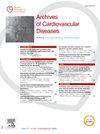Left atrial reservoir strain in ischemic stroke
IF 2.3
3区 医学
Q2 CARDIAC & CARDIOVASCULAR SYSTEMS
引用次数: 0
Abstract
Background
The search for a potential cardiac source is a fundamental step in the urgent evaluation of an ischaemic stroke (IS). The most common cardioembolic cause of IS is atrial fibrillation (AF). Recent studies have demonstrated the superiority of left atrial function versus LA dimensions as a predictor of paroxysmal AF, especially with the study of deformation anomalies using 2D Speckle-Tracking. Alteration of the reservoir strain (RS) of the left atrium (LA) is associated with the incidence of IS.
Objectives
The aims were to identify the association between RS with the embolic origin (cardioembolic and ESUS) of a IS/TIA, as well as the association of RS with the occurrence of AF, in patients with no known AF prior to their stroke nor anticoagulation treatment.
Methods
This is a retrospective observational study in patients hospitalised at the neurology service for IS or transitor (TIA) from January 2022 to April 2023, with no history of AF nor anticoagulation treatment and ho had had transthoracic echocardiography (TTE). We compared embolic (cardioembolic and ESUS) groupe versus non embolic and left reservoir strain < 20% groupe versus > 20% groupe.
Results
79 patients were included, 56% of whom were men, with an median age of 72 years. The mean RS was 27% and the RS was < 39% in 86% of cases. 39% of strokes were Cryptogenic (of which 26% were TIA), 23% Cardio-embolic, 14% ESUS. Among the cardioembolic causes (18 patients): 33% were secondary to AF, 39% to PFO, 16% to severe LV dysfunction. With a threshold of 20% and p value 0.012, the RS demonstrate a significant association with embolic stroke (group PFO excluded). RS < 20% was significantly associated with the occurence of AF with P-value 0.040.
Conclusion
Our study found that a left atrial reservoir strain < 20%, measured on echocardiography, in the acute phase of an IS, in patients with no history of AF or anticoagulant treatment.
缺血性脑卒中左心房储血池应变
背景寻找潜在的心脏源是缺血性卒中(is)紧急评估的基本步骤。IS最常见的心脏栓塞原因是心房颤动(AF)。最近的研究已经证明了左心房功能相对于左心房尺寸作为阵发性房颤的预测指标的优越性,特别是使用二维斑点跟踪对变形异常的研究。左心房(LA)储层应变(RS)的改变与is的发生有关。目的是确定RS与IS/TIA的栓塞起源(心脏栓塞和ESUS)之间的关系,以及RS与房颤发生的关系,这些患者在卒中前没有已知的房颤或抗凝治疗。方法本研究是一项回顾性观察性研究,研究对象为2022年1月至2023年4月在神经内科因is或TIA住院的患者,无房颤史,无抗凝治疗史,无经胸超声心动图(TTE)。我们比较了栓塞(心脏栓塞和ESUS)组与非栓塞和左储层应变;20%组vs >;groupe 20%。结果纳入79例患者,56%为男性,中位年龄72岁。平均RS为27%,RS为;86%的病例中有39%。39%的中风是隐源性的(其中26%是TIA), 23%是心源性栓塞,14%是ESUS。心栓塞原因(18例):33%继发于房颤,39%继发于PFO, 16%继发于严重的左室功能障碍。阈值为20%,p值为0.012,RS与栓塞性卒中有显著相关性(排除PFO组)。RS & lt;20%与房颤发生显著相关,p值为0.040。结论本研究发现左心房储层应变;超声心动图显示,在没有房颤史或抗凝治疗史的患者中,20%为IS急性期。
本文章由计算机程序翻译,如有差异,请以英文原文为准。
求助全文
约1分钟内获得全文
求助全文
来源期刊

Archives of Cardiovascular Diseases
医学-心血管系统
CiteScore
4.40
自引率
6.70%
发文量
87
审稿时长
34 days
期刊介绍:
The Journal publishes original peer-reviewed clinical and research articles, epidemiological studies, new methodological clinical approaches, review articles and editorials. Topics covered include coronary artery and valve diseases, interventional and pediatric cardiology, cardiovascular surgery, cardiomyopathy and heart failure, arrhythmias and stimulation, cardiovascular imaging, vascular medicine and hypertension, epidemiology and risk factors, and large multicenter studies. Archives of Cardiovascular Diseases also publishes abstracts of papers presented at the annual sessions of the Journées Européennes de la Société Française de Cardiologie and the guidelines edited by the French Society of Cardiology.
 求助内容:
求助内容: 应助结果提醒方式:
应助结果提醒方式:


